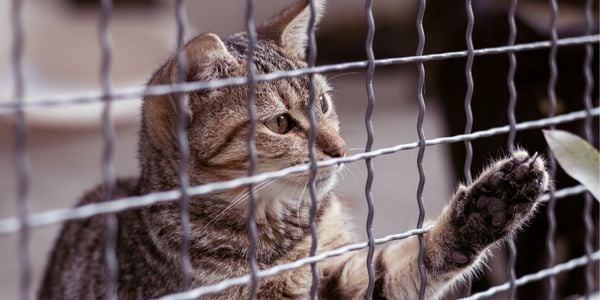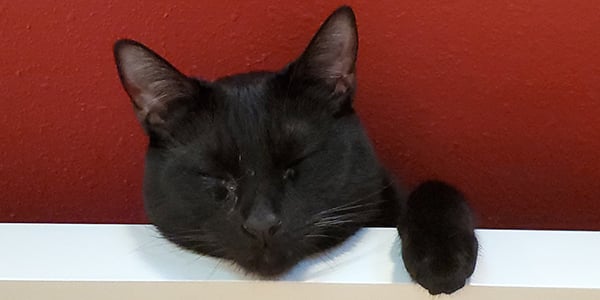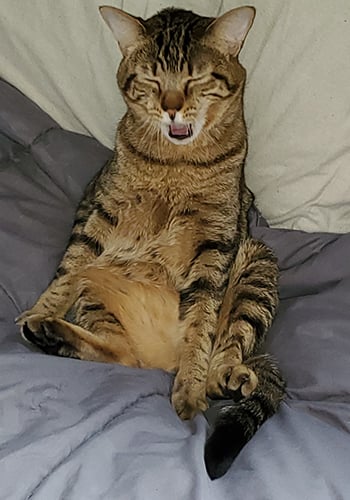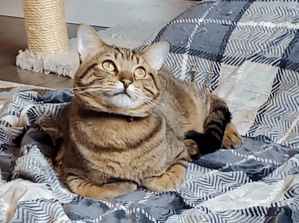
If you’re looking for a way to help animals, rescue organizations, and even families in your community, consider fostering! It’s an experience like no other. There’s a foster out there for just about any situation or lifestyle. It can be as simple or involved as you like. All you need is a little patience, a little space, and a lot of love.
Why I Became a Cat Foster Guardian
I grew up in a household where any animal in need of care was welcome. It was a revolving door of stray cats, dogs whose owners couldn’t keep them, injured, wild this and that, and once, a pregnant spaniel found wandering the desert, who soon gave birth to 14 puppies! It certainly wasn’t easy for my mother to manage and care for all these critters. But she never said no. Well, occasionally, she said no, but never really meant it.
When I moved out on my own, I knew I wanted to continue supporting animals in need, the way my family had. My plan was to buy a house and dedicate a spare room solely to fostering cats. It took a while, but I finally did it. I lovingly call it the Foster Suite. And it has been my absolute joy.
Why Foster a Cat?
Fostering Helps Your Local Animal Shelters and Rescue Organizations
 Fostering Helps Increase Animal Adoptions
Fostering Helps Increase Animal Adoptions
Every animal rescue that moves into a foster home frees up space for one the rescue wouldn’t be able to take in otherwise. It’s that simple. More foster homes mean more animals saved. Some rescues don’t actually have physical locations to house animals. They remove the animal from a negative situation — be it a stray, victim of abuse, pet in need of medical care, or pulled from an overcrowded shelter – and rely entirely on foster guardians to home the animals until they’re adopted.
Some animals come into the shelter in great physical and mental shape and can go up for adoption right away. They may not need fostering. However, the support of foster families who take in other long-term cases means more resources are available to quickly transition the ready-to-adopt animals. This reduces stress on the animals and the rescue organization.
Fostering Keeps Adopted Cats in Their New Homes
In some cases, foster homes provide a much-needed opportunity to see how a rescue animal will react in a home environment, before going up for adoption. It’s a chance to discover and work through any behavioral issues, provide training and socialization, as well as allow them to decompress and readjust before adoption. This can be the difference between a successful adoption and a return to the rescue. But don’t worry — you don’t have to be an expert in animal behavior to help a foster through this process.
Fostering Helps Rehabilitation
For those willing to take rehabilitation cases, fostering is wonderful for animals going through medical recovery, resolving behavioral problems, or in need of socialization (learning how to interact with people and/or other animals, deal with stressful situations, manage emotional and physical reactions to different stimuli). Having a calm space, and someone dedicated to helping them heal, makes for a smoother and speedier recovery.
Fostering Helps Animals in Need
We tend to think of rescue animals as strays living on the streets and maybe finding a bit of relief inside the rescue facility. While that’s true for many cases, it’s certainly not every case. As with my current foster cat, owners may give up a pet if they feel they are not able to care for them financially. Sometimes elderly pet owners may find they’re unable to keep up with the physical demands. My first foster was taken in by animal control because his owner was hospitalized. That’s just to say, there are many reasons why beloved cats and dogs find themselves in rescues. You never know what life holds.
 Ollie’s Story – Eight Months in the Rescue
Ollie’s Story – Eight Months in the Rescue
You might wonder if moving from the rescue facility to a foster home and then to a forever home really does the animal much good. I say ABSOLUTELY! Let me tell you a little about my current foster cat, Ollie, just to paint the picture of life at the rescue facility.
At a few months old, his leg was badly broken. He was surrendered by his family due to the high medical costs. For the next eight months, the rescue organization cared for him, paying for, and seeing him through, multiple surgeries (every one of which had complications). That’s eight months at the shelter, and he’s only 12 months old.
They have a great facility, but it’s not a home environment. He lived in a small kennel area, on bed rest much of the time. The staff cuddled and played with him as much as they possibly could. But they have an entire establishment to run. Their time can be limited.
Some shelters can also be a very loud environment. Think about the noise at your local dog park, but in a concrete building with high, reverberating ceilings — that was what Ollie would hear in his shelter. That was the first year of this kitten’s life. He was getting the best possible care from people who loved him and spared no expense to help him. He was doing okay. But even a loud, hectic week at the office can leave us needing a vacation.
It’s incredibly beneficial for animals going through a stressful rehoming experience, to get into a safe, quiet, stable home while they await their adoption. Ollie is now safe and sound with me, working through some understandable socialization issues and awaiting amputation as a last resort to heal his injuries. After surgery, he’ll recover here, in a peaceful, loving, attentive home, until he’s adopted.
Fostering Provides Pre-Adoption Assessment and Adjustment
It’s a safe bet that an animal in the rescue environment isn’t showing their true personality. Shelter staff conduct behavior assessments and get to know them as best they can. But it’s not always a 100% reliable evaluation with all the stress and stimuli of a rescue environment.
Move that animal into a foster home, and it’s a totally different story. As a foster parent, you have the opportunity to see what kind of lifestyle the cat will thrive in, their likes and dislikes, whether they have any training or behavioral issues, fears, or special needs to be addressed. This insight is invaluable when the rescue organization is trying to place the animal with the perfect forever family. The rescue counts on these insights to find the best possible adoption match for the animal.
You’re also giving the cat a chance to settle back into themselves, shake off past negative experiences, let down their guard, and become a family member again before they step into their forever home. The last thing anyone wants is for an adoption to turn negative and a pet to be returned. But it happens. Allowing the animal to flow through a foster home first sets everyone up for a more successful adoption and happy-ever-after.
I have to pause for a minute and tell you, I’m going to be finishing this story with even more joy and dedication than I initially thought. I just went in to check on my foster, who arrived yesterday and has been very standoffish. He loves his new space. But he wants nothing to do with me – growling every time I enter the room.
Well, I took a break from writing and popped in on him. He gave me the sweetest look, stretched out his paw and started purring like crazy. I was able to pet him for the first time, after a day of nothing but growls and hissing. Such a simple thing. But it took my breath away. That’s what this is all about. He felt safe enough to settle in and open up. It’s a beautiful thing!
(a photo of Ollie snapped just as I opened the window in his room for the first time and he felt the breeze on his face)
Fostering Animals Has Benefits for Humans
Whether you foster long-term cases, focus on healthy fosters, or work with those who have medical, behavioral, or socialization needs, it’s a way of giving back you’ll never want to stop. There’s a sense of value and self-worth that comes from fostering (call it the selfish side of selflessness) that I find I really crave when I’m in between fosters.
Fostering Animals is Good for Mental Health
My cat fosters generally stay in their room, separate from my fur babies. I’ve come to enjoy those moments during a busy day when I go into the foster room, close the door, and can just sit in the quiet, focusing on nothing more than bonding with a cat who needs love. It’s almost like meditation, and I get to do it throughout the day.
Let’s take it deeper. You’ll find many stories of people who, at a low point, became foster parents and believe it saved them. I can tell you from experience this latest foster cat had an unexpected impact on me. I’m writing this story amid the coronavirus lockdown. I work from home and live alone. So, it has been a lonely and challenging few months.
I’ll admit, the last few weeks were especially rough. I could feel myself slipping into a funk and frankly wondered how I’d pull myself out of it. Then I got the call. As soon as I heard the words, “I think we have the perfect foster cat for you,” my entire mood changed. I was focused, motivated, and most importantly, had something bigger than myself that demanded I shake it off and get to work.
Fostering is Good for Your Physical Health
Those of you who have pets at home know there are physical benefits to having them around. Though it may feel like they raise your blood pressure when they’re particularly frisky, studies show that having animals in the home can:
- Decrease blood pressure, triglyceride levels, and cholesterol
- Several studies show heart attack patients with a pet at home survive longer than those without a pet
- Increase physical activity overall
- Lessen anxiety
- Lessen the risk of developing allergies and asthma in children
- Increase social engagement (or as WebMD put it, “Dogs are great for making love connections.”)
- And that’s just the beginning!
Sources: CDC: About Pets & Their People, WebMD: 5 Ways Pets Can Improve Your Health
To learn more about all the different ways pets make our lives better, check out The Pet Effect campaign from Zoetis Petcare and the Human Animal Bond Research Institute.
What About Giving Up Your Foster Cat?
While we’re on the subject of physical and mental health, it’s natural to wonder what happens when the time comes to say goodbye. We’ll talk more about this in future articles. But here’s the way I look at it — my ultimate goal, at the end of the day, is to say goodbye to my fosters. That’s why I’m doing what I’m doing. It’s not a bad thing. It's success and means I did it — I got this little fur ball through. I showed them love and I kept them safe. I helped them heal. All so they could have a beautiful life with a family who needs them.
I’m a step in their journey, not their destination. Do I ugly cry? Yep! But I’m also happy crying. If I were to sum up the emotions in one word … well … I wouldn’t. One word isn’t enough. So here are the first 28 that come to mind: overwhelming happiness, sadness, a sigh of relief, a new opportunity for another foster cat in need, the start of the most amazing life for an animal I love.
Want to hear more about my foster story? Listen to this episode from the archives of the Paws & Play Podcast:




